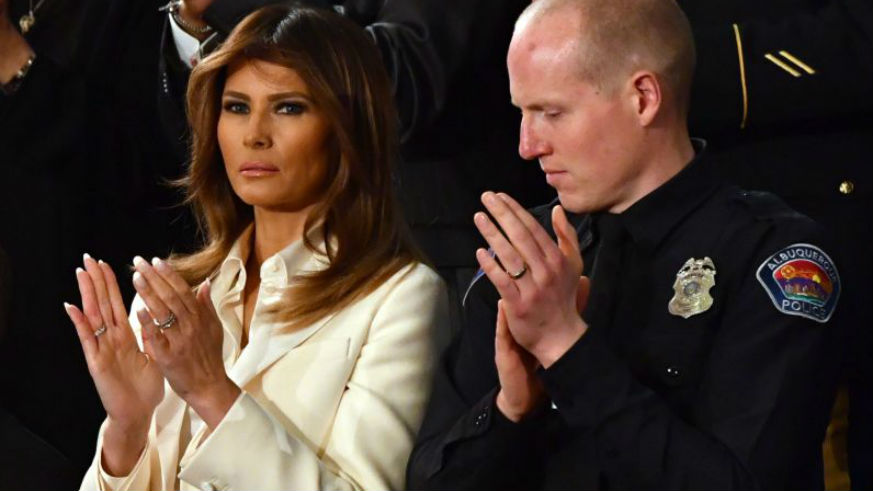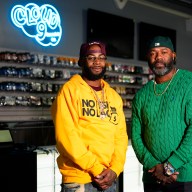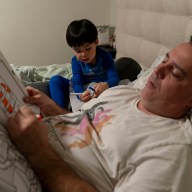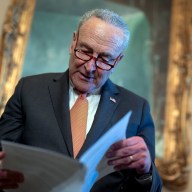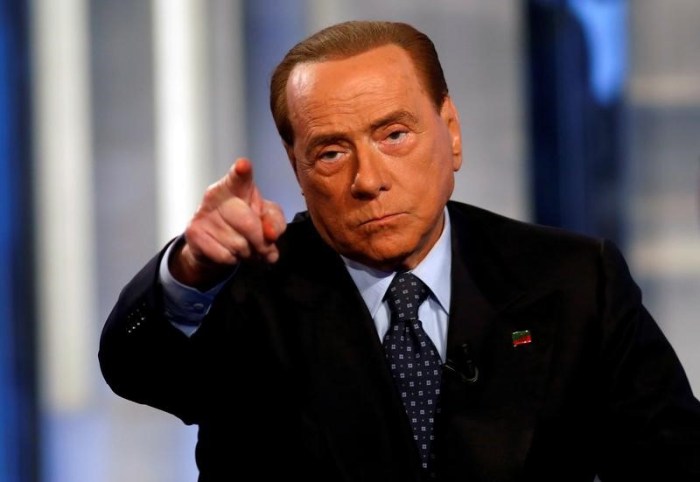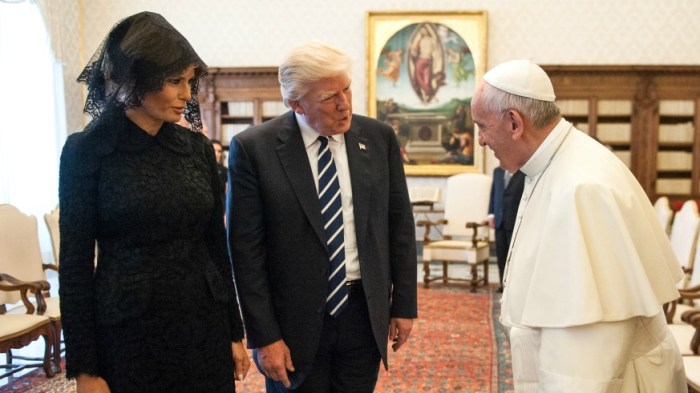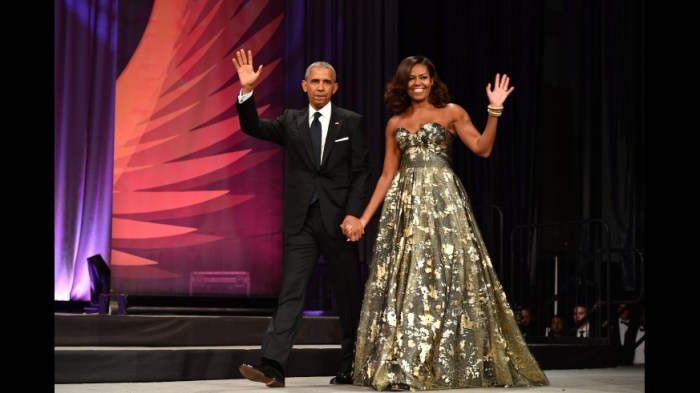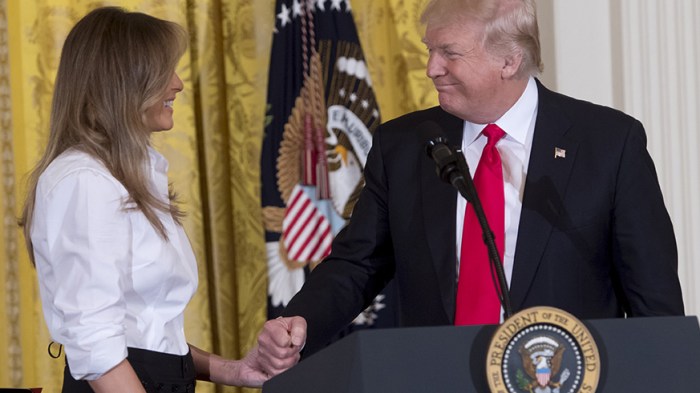Amid rumors that Melania is “furious” at Trump for his alleged sexual encounter with porn star Stormy Daniels, it wasn’t long after Tuesday night’s State of the Union that the press and public alike called out the first lady for her seemingly detached, unenthusiastic demeanor — glum-faced sometimes, stiff often.
If Melania Trump is starting off like this, how miserable will she be by the end of the speech? #SOTU pic.twitter.com/EbCnGxKW6X
— Matt Wilstein (@mattwilstein) January 31, 2018
Stephanie Grisham, Melania’s director of communications, took to Twitter last week to denounce reports that the first lady was on bad terms with her husband: “The laundry list of salacious & flat-out false reporting about Mrs. Trump by tabloid publications & TV shows has seeped into ‘main stream media’ reporting. She is focused on her family & role as FLOTUS — not the unrealistic scenarios being peddled daily by the fake news.”
Regardless, there were many non-verbal cues from the former model at Trump’s address, and the world took notice. Let’s start from the beginning, shall we?
Trump and Melania take separate cars
Grisham said in a statement that the Trumps made separate trips because Melania wanted to spend more time with the her special guests before the SOTU.
First lady Melania Trump arrives at the State of the Union separately from the President https://t.co/dUKdBTgtQD pic.twitter.com/MwqvN6luMo
— CNN Politics (@CNNPolitics) January 31, 2018
However, to make the case that their separate arrivals to the Capitol insinuated growing tensions between them, is too far-reaching, Dr. Lillian Glass, a body language and communication expert from L.A., told Metro.
“This was one of the most powerful and most serious speeches that Trump gave in his life,” Glass said. “Usually he’s cavalier, off the cuff, but he had to really speak to the people. He wanted to do everything possible to communicate [that]. In doing so, he may have needed his own space.”
Patti Wood, body language expert and author of “Snap: Making the Most of First Impressions, Body Language, and Charisma,” told Metro she disagrees. According to her, Melania’s choice to go in separate cars was symbolic in that she was saying, “I don’t want to travel with you. I don’t want to get in a seated car with you.” And as Wood put it, “she was taking a risk doing that.”
Melania’s entrance
“[Melania] was very regal,” Glass said. “She took one step at a time and was very, very serious.” This could have been, in part, because she “realized the seriousness of the occasion. She probably felt the opposition, too.”
Though reserved, Melania entered with a smile, which Glass said was very “appropriate” of her.
First lady @FLOTUS Melania Trump receives standing ovation as she enters ahead of President Trump’s State of the Union address. #SOTU video ABC pic.twitter.com/cxEupKqtOT
— Trad American Angel (@RightWingAngel) January 31, 2018
Melania interacts with guests
Though Glass pointed out that Melania looked “very somber” during the speech, with her guests, she was “very warm and positive, very engaged and receptive of others.”
Glass cited the first lady’s interaction with guest Ryan Holets, a New Mexico police officer who, along with his wife, adopted a baby born to a homeless heroin addict. “Melania spoke to him and was very warm and gracious,” Glass said.
“You embody the goodness of our nation”: President Trump honors Officer Ryan Holets and his wife, Rebecca, during his State of the Union address for adopting the baby of a homeless woman addicted to heroin. The couple received a standing ovation. https://t.co/gU14NRwlHu #SOTU pic.twitter.com/0LHB1ngUTp
— CNN Breaking News (@cnnbrk) January 31, 2018
Wood stated that Melania did this deliberately — she wanted to differentiate how she treated her guests from how she felt about Trump.
“With them,” Wood explained, “she wanted to say, ‘I’m a nice person, I have this other part of me that I want to show the world…that I can be a happy, nice person. I want to distinguish how I feel about the rest of the world from how I feel about my husband.'”
Melania stays seated
People took notice that Melania didn’t stand when Trump spoke of “faith and family” during the SOTU, despite the fact that the guests around her did.
Some claimed this could have been a burn — an intential shot at her husband in light of the Stormy Daniels rumors.
.@FLOTUS Melania Trump – winner of ‘Best #SOTU Burn’
??
Melania Trump stays seated when Trump praises ‘faith and family’ as ‘center of American life’ — and declares ‘in God we trust’ pic.twitter.com/QjAViYlMkT— Maggie Jordan: (@MaggieJordanACN) January 31, 2018
Glass said that the Trumps are “too smart and savvy to air their dirty laundry. They’re not doing it in public.” To claim Melania is angry at Trump, Glass said, is “wishful thinking.”
Wood, on the other hand, stated that Melania had to actively control the urge to stand, and so it was a conscious decision to remain in her seat. “She had to fight against the normal energy of rising and standing, and she chose to stay seated,” Wood said. “That is disrespectful in a way.”
“She must have known that was coming,” Wood continued. “She’s making a statement about family. This is a time when I said to myself, ‘She’s smarter than I thought. She’s more deliberate in her actions than I thought.”
A fashion statement?
Everyone is trying to figure out what Melania’s white Dior pantsuit could have meant. Was it a nod to Hillary Clinton? A way of saying, “I’m innocent“? A means of honoring the women’s suffrage movement? Or an objection to her husband as an assertion of power?
Melania Trump’s white pantsuit means one of two things: 1) she’s giving a nod to @HillaryClinton or 2) she’s giving a nod to #TimesUp . Either way, she’s saying she hates her husband. #SOTU
— Jackie_O_Classist (@JackyOhClassist) January 31, 2018
Melania’s white suit is reminiscent of the white that was the Democratic women’s color of choice last year — they wore a color associated with the suffragette movement to show support for policies such as equal pay for equal work.
— Siobhan Hughes (@siobhanehughes) January 31, 2018
Whatever the reason, Wood said it wasn’t an accident.
“She always makes a choice in her fashion,” Wood said. “She knew what the other messages were, and she chose to say, ‘OK, I’m different and unique, I’m not doing the normal thing.'”
Melania’s sharp angles
Wood also noted that Melania had sharp angles in her facial expressions — in her scowl, cheeks and lips. These are read, Wood said, as anger.
Glass, however, argued that when it comes to this sharp, “angry” look, it’s not a given that rumored tension with her husband is to blame — it could have been the weight of Tuesday night’s speech or her general discomfort being in the spotlight.
Glass pointed to Melania’s modeling career. “Look at her training…she knows how to be in front of the camera,” Glass said. But this — her role as First Lady — doesn’t compare.
“Even though she’s been in the public eye, this is 24/7, and her mental mindset is that she’s a mom,” Glass explained. “So when she’s thrust in these positions [as FLOTUS] she’s uncomfortable.”
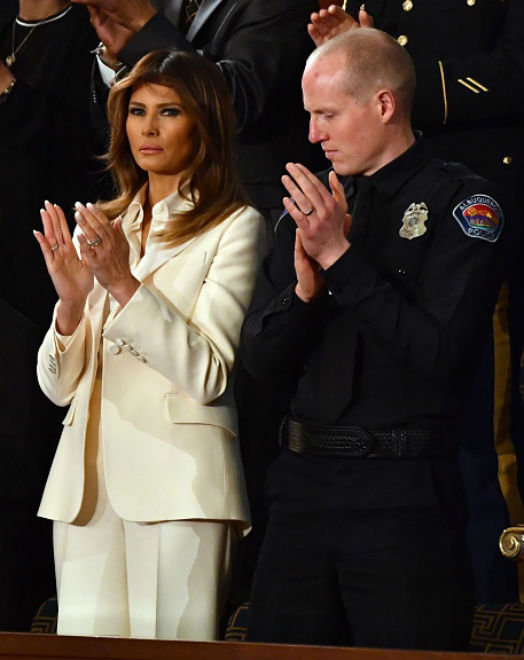
But Wood has a different point of view.
A key part in analyzing non-verbal cues, she explained, is considering the situation and context of what’s going on. “The looks of anger on her face were so significant and so severe,” Wood said. “And then you look at the relationship, and it’s his wife. It’s the most hatred I’ve ever seen on her face.”
Wood continued on to say that all of Melania’s cues discussed earlier were conscious choices to separate herself from Trump. But with her sharp angles — with her anger — she chose not to control it and risk the public seeing her expressions. “She must feel the world has to know…he has to know.”
“I’ve been reading her for a long time,” Wood said. “I’ve seen her tense and afraid and muted and looking like she was abused, and this was not that. Before, we’ve been thinking of her as this submissive person, but [Tuesday night] I didn’t see her fearful.”

